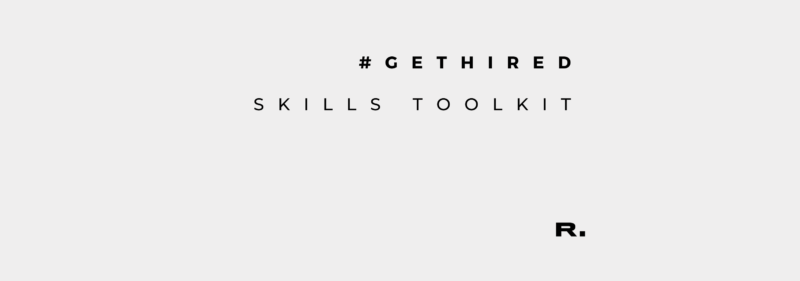Found yourself out of work for the first time in a long time? We’ve launched the #GetHired Skills Toolkit as a simple and actionable step by step guide to secure your next role. Access the full kit here.
Job interviews come in many forms. Whether it’s a casual chat over a coffee or a 10 person, activity based three part interrogation, it’s purpose is to ascertain;
- Whether you have the right skills and experience to excel at the role
- If you’re a good fit for the organisation’s culture
- If your personal professional ambitions align with the business
Firstly, try and anticipate the questions they’ll ask. ‘Tell me about yourself’ is likely to be one of the first. Don’t be tempted to skip over it in your preparations. Having a smooth response to an opening question will help you feel more confident as the interview progresses. Start by writing a couple of bullet points covering your professional experience and achievements and then expand it into a succinct and flowing answer.
The STAR technique
Once you’ve built a bank of questions you could possibly be asked, you need to prepare answers for them. Answering interview questions is an art, but one you can practice. The STAR technique allows you to apply structure to your answers, providing context and ensuring you don’t miss any critical details out.
Like all good acronyms, it’s nicely condensed in an easy to remember format. This will help you present applicable examples from your work history to answer the question and demonstrate how you would respond to tasks within the business.
Let’s look at applying the STAR method to;
‘Can you tell me about a time where you’ve demonstrated leadership skills?’
Situation
Think of an example which will best illustrate what the interviewer is asking. That could be from your work, education or volunteer experience. Start by setting the scene. This will provide some context around the situation or challenge that you faced.
Keep this bit brief. You want to spend the majority of your time discussing the actions you took and the results you achieved. Keep it short and sweet by providing two or three points to paint a picture for the interviewer. This will provide insight into why you acted the way you did.
“In my last role as a social media manager for a SaaS tech business, I found we were experiencing increasingly negative engagement on Twitter. The customers were unhappy about the service they received from our support team and publicly calling out the business, damaging the brand.”
Task
This section asks you to cover what responsibility you had in relation to that situation or challenge. Again, don’t go into too much detail here, you want the bulk of your answer to focus on the results. Provide two or three points which illustrate the task you needed to complete.
“As the social media manager, I was responsible for protecting our brand and moving social media complaints off a public forum as quickly as possible while supporting customers in resolving their issues if I could.”
Action
This is where you can provide more detail on what you did in response to the challenge. Take care to explain what action you took, step by step in detail as this will reflect how suitable you are for the role and the organisation. Even if you responded to the challenge in a group setting, make sure you focus on what action you took personally to drive results.
“Initially, I offered a public response to Twitter complaints, quickly following up with a private message to get more information. I’d then visit the support team and try to get an agent to handle the complaint.
The support team were often under a lot of pressure and could not get back to the customer with the urgency required. I didn’t have the technical knowledge to support the customer so I arranged a meeting with my manager and the Head of Support. From here, I suggested implementing a social media escalation process to ensure complaints wouldn’t get missed.
I took ownership of this project to work with the CRM and support teams to create a process that would automatically flag up social media complaints on the system. I then provided a training session for members of the support team to respond to complaints using appropriate tone and language within our brand guidelines.”
Result
This is where you want to showcase what you achieved as a result of the action you’ve taken. Don’t be shy, this is where you can really sell yourself to show you’re the right person for the role. If you can quantify your results in numbers this will really help show how effective your actions were.
You can also use this as an opportunity to highlight what you learned and how raising to the challenge made you a better (and more desirable) employee.
“The social media escalation process really optimised the complaints procedure. I was no longer having to focus my efforts in responding to negative feedback online and could focus on creating content to promote the business. The integration with our social media and CRM also ensured customers complaints were managed in a one hour turnaround time. One touch resolutions saw the business enjoy a 2 point increase in their positive Trustpilot reviews over the quarter.
Taking the lead of this project afforded me the opportunity to collaborate with different areas of the business. I learnt a lot about our internal processes and enjoyed running the training sessions for the support team, which is when I realised I wanted to pursue the learning and development aspects of my role further.”
If you can break down each question using this formula, you’ll cover all the key points the hiring manager wants to hear. You can practice applying using STAR for common interview questions. This will ensure the structure feels natural to you if you get caught with a question you haven’t prepared for.
Never underestimate the importance of practicing your answers aloud. This will help you understand how you formulate your response and get a feel for the amount of detail you need for each question. Practice makes perfect and the more you do it, the more comfortable you’ll feel during the real thing. Get someone you trust to run through some questions so you can hear how they sound out loud.
Ready to take the next step? View the next chapter in our #GetHired Skills Toolkit
Other Reads

3 Minute Read 08.12.20
Be SMART in your job hunt goals
Found yourself out of work for the first time in a long time? We’ve launched the #GetHired Skills ...

4 Minute Read 08.12.20
CV Best practice
Found yourself out of work for the first time in a long time? We’ve launched the #GetHired Skills ...



2 Minute Read 08.12.20
How to customise your job application
Found yourself out of work for the first time in a long time? We’ve launched the #GetHired Skills ...